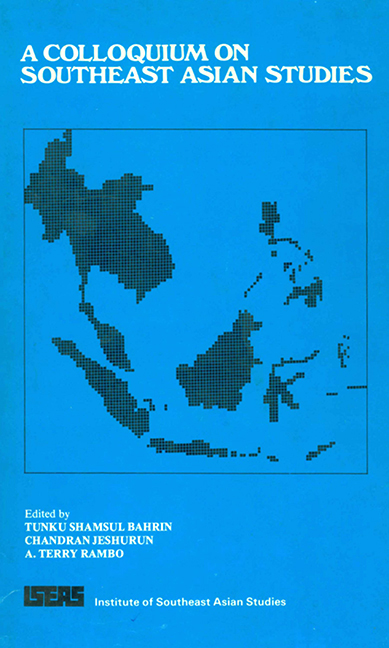Book contents
- Frontmatter
- Contents
- Foreword
- Preface
- Acknowledgements
- Introduction
- Contributors
- PART I TEACHING AND RESEARCH
- THE CONCEPTUAL THEORIES
- THE EXTRAREGIONAL EXPERIENCE
- THE REGIONAL PERSPECTIVE
- 8 Southeast Asian Studies in Indonesia
- 9 Southeast Asian Studies in Malaysia
- 10 Southeast Asian Studies in the Philippines
- 11 Southeast Asian Studies in Singapore
- 12 Southeast Asian Studies in Thailand
- THE PROBLEMS OF TEACHING AND RESEARCH
- PART II ENVIRONMENT AND DEVELOPMENT
10 - Southeast Asian Studies in the Philippines
from THE REGIONAL PERSPECTIVE
Published online by Cambridge University Press: 21 October 2015
- Frontmatter
- Contents
- Foreword
- Preface
- Acknowledgements
- Introduction
- Contributors
- PART I TEACHING AND RESEARCH
- THE CONCEPTUAL THEORIES
- THE EXTRAREGIONAL EXPERIENCE
- THE REGIONAL PERSPECTIVE
- 8 Southeast Asian Studies in Indonesia
- 9 Southeast Asian Studies in Malaysia
- 10 Southeast Asian Studies in the Philippines
- 11 Southeast Asian Studies in Singapore
- 12 Southeast Asian Studies in Thailand
- THE PROBLEMS OF TEACHING AND RESEARCH
- PART II ENVIRONMENT AND DEVELOPMENT
Summary
The Southeast Asian Studies programme of the Philippines is the result of an effort by the country's past and present leadership to reorientate the heavily Westernized educational curricula towards the development of an Asian identity among Filipinos.
Efforts in this direction were initiated by President Ramon Magsaysay who established the Institute of Asian Studies at the University of the Philippines in 1954. He meant the Institute to “make our highest institution of learning the common ground in which to bring together scholars and students in Asia to develop among themselves a spirit of stronger kinship, mutual helpfulness and solidarity and render fit to serve as a rallying point in the joint endeavor of all Asians to preserve and advance their common cultural heritage”.
A team of professors was sent abroad to observe academic programmes on Asia in various universities in the United States, Europe and Southeast Asia. On the basis of their observations, the team presented a study programme for the proposed Institute of Asian Studies. Meanwhile, a committee was formed to formulate a plan for the proposed Institute's administration and operation.
The Institute of Asian Studies
The University Board of Regents established the Institute of Asian Studies (IAS) at its 604th meeting on 28 November 1955. The Institute was placed under the administration of the College of Liberal Arts, though functioning as a separate unit with its own budget. The following year, under Appropriations Act No. 1800, the IAS was given an appropriation separate from the University budget for the Fiscal Year 1957-58.
In line with the express directive of President Magsaysay, the Institute was assigned the task of giving an Asian viewpoint to the curricula of all departments of the university, particularly those of the College of Arts and Sciences where courses covering the various aspects of Philippine history and government of other Asian countries were already being offered.
- Type
- Chapter
- Information
- A Colloquium on Southeast Asian Studies , pp. 107 - 117Publisher: ISEAS–Yusof Ishak InstitutePrint publication year: 1981



